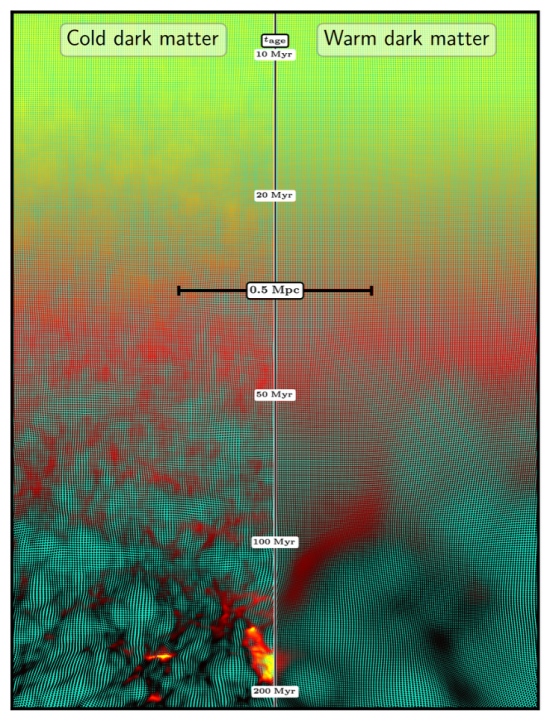16 September, 2025
The University of Tokyo Kavli Institute for the Physics and Mathematics of the Universe (Kavli IPMU, WPI)

An international research collaboration has used advanced computer simulations to investigate how faint radio signals from the early Universe, soon to be observed from missions on the far side of the Moon, could shed light on the fundamental properties of dark matter, reports a new study published in Nature Astronomy on September 16, 2025.
Ordinary matter, which makes up the stars, planets, and everything we can see, makes up only about 20 per cent of all matter in the Universe. The remaining 80 per cent is believed to be dark matter: a mysterious substance that does not emit, absorb, or reflect light, and whose true nature remains one of the greatest unsolved problems in modern physics. Despite its invisibility, dark matter is known to play a vital role in the formation of galaxies, such as the Milky Way, and in shaping the large-scale structure of the Universe.
One of the key properties of dark matter is the mass of its constituent particles. If these particles are relatively light, such as less than about 5 per cent of electron mass, then dark matter is considered warm and would inhibit the formation of structures smaller than galaxies. However, if the particles are heavier, dark matter is classified as cold, which would promote the growth of smaller-scale structures.
Astronomers have long sought to determine the dark matter particle mass by studying small-scale structures composed of gas and stars because this information is crucial for particle physicists to develop theoretical models of dark matter.
A new study led by The University of Tsukuba Postdoctoral Fellow Hyunbae Park, who carried out this study during his time as a University of Tokyo Kavli Institute for the Physics and Mathematics of the Universe (Kavli IPMU, WPI) Project Researcher, and including Kavli IPMU Professor and Max Planck Insitute for Astrophysics Visiting Scientist Naoki Yoshida, focused on small gas clouds that existed during the cosmic Dark Ages, the first 100 million years after the Big Bang before the formation of stars and galaxies. Because the formation and evolution of stars and galaxies involve complex and poorly understood processes, simulating their behavior accurately remains a major challenge in modern computational astrophysics. By targeting an era before these complexities arose, the researchers were able to simulate early cosmic structures with unprecedented precision.
The simulation results (Figure 1) revealed how gas gradually cooled as the Universe expanded while developing small gas clumps via gravitational interaction with dark matter during the Dark Ages. The gas in these clumps became much denser than in the average Universe and heated up due to compression. This variation in density and temperature was imprinted in the 21-centimeter radio emission from hydrogen atoms. The team modeled this ancient signal from the primordial gas clouds and found that its sky-averaged strength depends sensitively on whether dark matter is warm or cold (Figure 2). According to the researchers, this difference could allow future lunar experiments to distinguish between competing dark matter scenarios.

The Dark Ages signal is expected to appear at frequencies around 50 MHz or lower with a characteristic frequency modulation, and the difference between the two dark matter scenarios is less than a milli-kelvin in brightness temperature (Figure 2). These frequencies are heavily contaminated by human-made signals on Earth, and further obscured by the ionosphere making it virtually impossible to detect the signal from ground-based observatories. In contrast, the far side of the Moon offers a radio-quiet environment, shielded from terrestrial interference, and is considered an ideal location for detecting the elusive Dark Ages signal (Figure 3).
Although building radio observatories on the Moon poses major technological and financial challenges, an increasing number of nations are pursuing such missions as part of the new space race, combining scientific ambition with technological advancement. With this growing international momentum, it is now considered feasible to determine the mass of dark matter particles through lunar-based observations in the coming decades. Among these nations, Japan is actively developing the Tsukuyomi project, which plans to deploy radio antennas on the Moon.
The team’s research provides essential theoretical guidance for these near-future missions to maximize their scientific return.

Paper details
Journal: Nature Astronomy
Title: The Signature of Sub-Galactic Dark Matter Clumping in the Global 21-cm Signal of Hydrogen
Authors: H. Park, R. Barkana, N. Yoshida, S. Sikder, R. Mondal, and A. Fialkov
Author affiliations:
(HP) Center for Computational Sciences, The University of Tsukuba
Computational Cosmology Center, Lawrence Berkeley National Laboratory,
Kavli IPMU, The University of Tokyo
(RB) School of Physics and Astronomy, Tel Aviv University
Kavli IPMU, The University of Tokyo
(NY) Kavli IPMU, The University of Tokyo
Max-Planck-Institute for Astrphysics
(SS) School of Physics and Astronomy, Tel Aviv University
(RM) Department of Physics, National Institute of Technology Calicut
(AF) Institute of Astronomy, University of Cambridge
DOI: 10.1038/s41550-025-02637-0 (published 16 September 2025)
Paper abstract (Nature Astronomy)
Research contact
Naoki Yoshida
Professor
Kavli Institute for the Physics and Mathematics of the Universe, The University of Tokyo
and Department of Physics, The University of Tokyo
E-mail: naoki.yoshida _at_ ipmu.jp
* Please change _at_ to @
Media contact
Motoko Kakubayashi
Press officer
Kavli Institute for the Physics and Mathematics of the Universe
The University of Tokyo
TEL: 04-7136-5980
E-mail:press_at_ipmu.jp
* Please change _at_ to @
Related links
Computer Simulations Show Lunar Observatory Could Reveal Dark Matter's Secrets (Naoki Yoshida's website)






